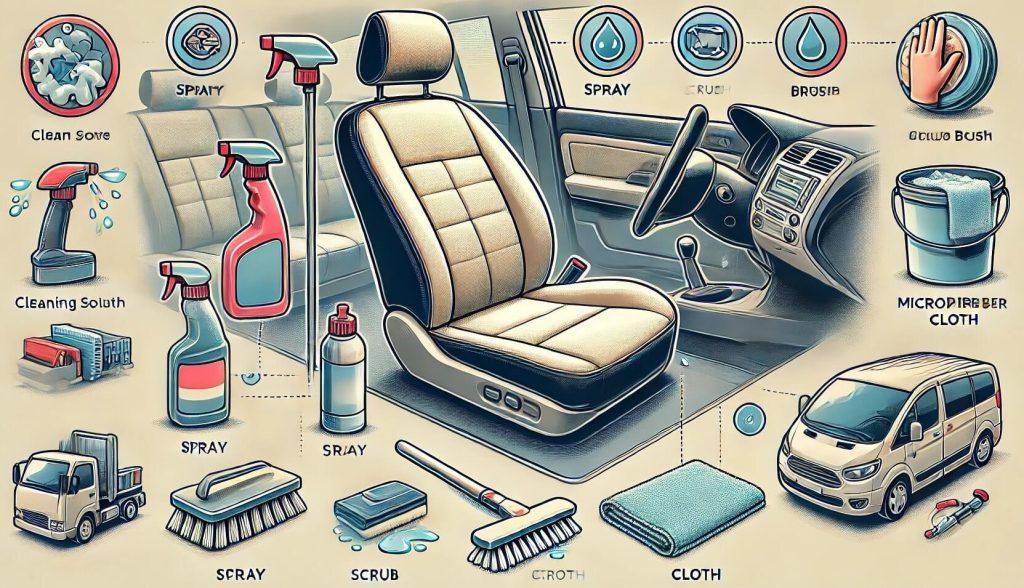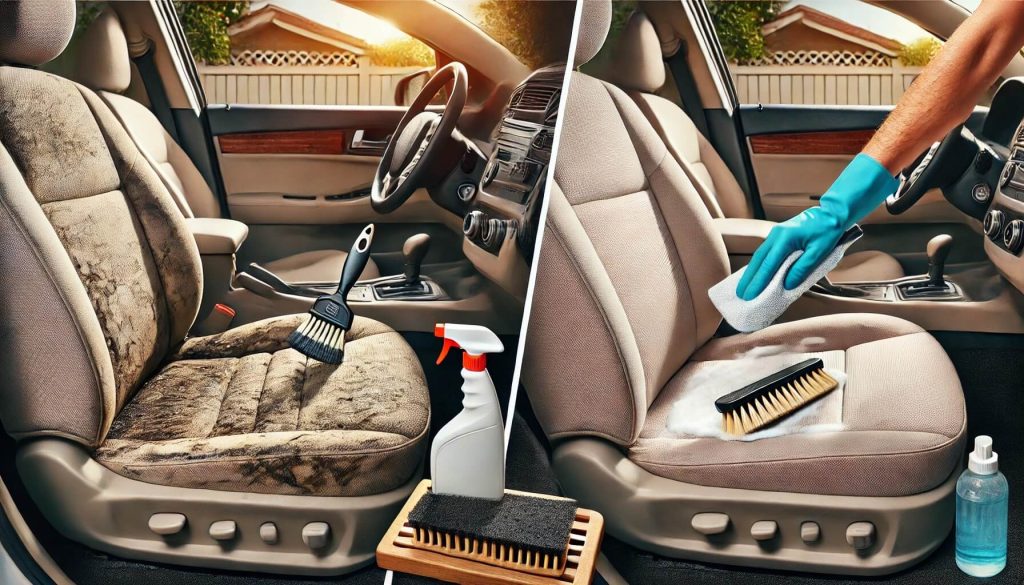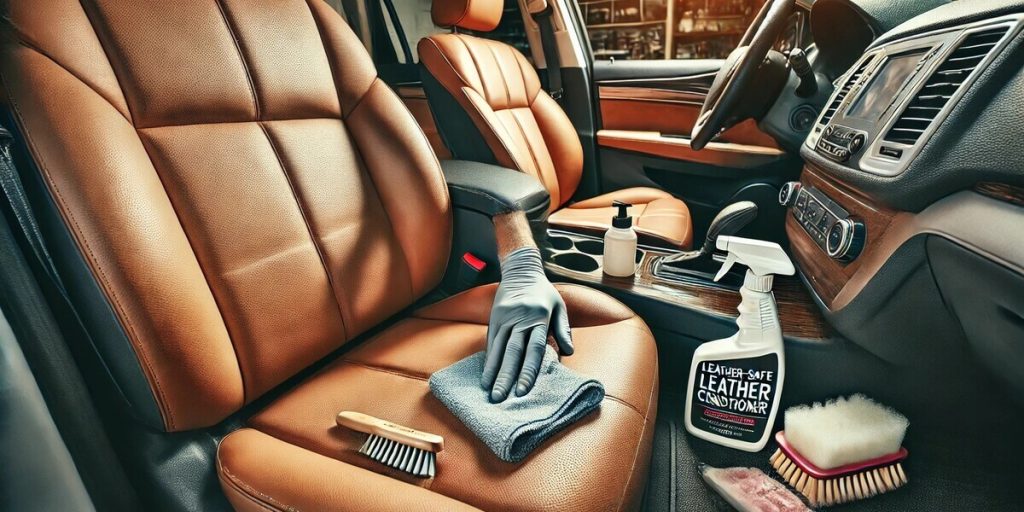Last Updated on February 17, 2025 by Mark S. Taylor
Last year, on a busy Monday morning, I spilt my cup of coffee while getting into the car. During the entire drive to work, there was this stain lingering over the smell of the coffee. That is when I knew I had to research it. Even though I had never in my life encountered such a situation, I chose to research it. The process of cleaning the coffee stain was surreal.
The first thing I realized was that my seats were made of durable fabric and were absorbent at the same time, so I travelled to get a solution. Vinegar and water were the perfect combination, as well as a soft brush. These were the best finds of my life. This was solely to stop the smell from sticking and further to scrub the stain, which consisted of a one-part vinegar and two-part water mix. So, to begin. Much to my amazement, the whole thing worked out beautifully.
Before, I didn’t see the reason to have a cleaning kit in my car, but now I do and it gets the job done. Knowing your seat material, in conjunction with acting fast, makes all the difference. There really is an easier way to handle car seat stains than one would think! So follow my advice, and it will be simpler for you.

Contents
Car Seat Cleaning Requirements Based On Yeh Material
The various materials used in the car’s seating areas are responsible for their different needs:
Fabric Seats: These types of covers can be found in a lot of vehicles, as it’s very easy to get dirty and absorb stains. Even though these types of curtains are quite strong and tough, they must be cleaned regularly to prevent foul smells and discolouration.
Leather Seats: Even though these are luxurious and really durable, these seats can be susceptible to scratches and can be damaged with harsh chemicals. Therefore, it is essential to use conditioning skin so that the material can remain soft and shiny.
Vinyl Seats: These vinyl coverings can be easily cleaned since they are water-resistant, although if not properly maintained, they’re prone to discolouration or even cracking.
Once you understand your seat fabric, you can decide what the best cleaning method would be.
Common Causes Of Stains On Car Seats
Following the recommended instructions can provide a much easier and simpler solution to removing car seat stains.
Food and Drink Spills: Messy eaters of all types, including children, appear to be coffee, juice, or even fast food lovers.
Dirt and Mud: Cleaning shoes can prevent dirt and mud from becoming valuable assets. However, this was particularly common during rain.
Evidence of Grease and Oil: Especially visible on tools or car repair, these stains are difficult to get rid of.
Ink Stains: Children love to paint and would love to do so on the interior of the car, but the ink and marker stains are truly annoying.
Understanding where the stain originated from gives you an insight into how best to clean the stain.

How To Remove Stains From Car Seating: A Detailed Walkthrough
Here is a Quick Walkthrough of the steps to tackle the stain;
Step 1: Note the Stain and the Fabric Section
- What kind of stain are you working with, oil stain, food, or perhaps ink?
- Your car owner’s manual should be cross-referenced for information about the seat’s care instructions.
Step 2: Prepare Your Cleaning Tools and Products
- Required Equipment: Vacuum mop, cloth mop, few brushes, and a spray bottle.
- Home Ingredients: like Baking soda, vinegar and liquid detergent.
- Ready Made Items: Furniture fabric cleaner, leather conditioner and strong cleaners with enzymes in them for very dirty areas.
Step 3: Stain Marking Off
- For new stains, please press against the surface as much as possible to wipe the stain off effectively.
- Choose a small area that’s out of sight to try out your stain remover so that in case of discolouration, it won’t be a problem.
Step 4: Removing the stain
Fabric Seats
Combine one part white vinegar, two parts water, and a small amount of detergent. Apply the vinegar mix to the stain, using a gentle brush to scrub the area. Wipe with a wet cloth.
Leather Seats
Use a soap and water solution or another leather-safe cleaner. Dampen a microfiber cloth with the solution, gently rub, and then dry. Do not soak the leather.
Vinyl Seats
Wet the stain with water and soap or protectant spray. Massage the area with cloth in circles, and dry the area.
Step 5: Re-rinse and Dry
- Use a wet towel to wipe off any leftover shampoo.
- Let the chairs dry out themselves or use a fan. Evacuate any water present to avoid mould.
Cheap Alternatives vs. Branded Products: The Good and The Bad
How to make your graffiti remover
- Pros: Looks presentable and is bio-safe.
- Best for: Cleaning stains and performing regular maintenance rounds.
- Cons: Weak and ineffective on stubborn stains.
Branded cleaning products
- Pros: Makes erasing confrontational a breeze.
- Best for: Restoration of old leather and removing heavy stains.
- Cons: Expensive.
According to the fabric of your car seat and the level of stain, select the correct method.

How to stop stains from occurring in the first place
- Installing Seat Covers: Covers the seat from spills and dirt and also helps with wearing.
- Cleaning Up Spills Quickly: Make sure to clean spills at the very moment of their occurrence so the stains never receive a chance to form.
- Cleaning and Caring for the Car Seats: Set Roomba every Tuesday to vacuum and contact professional seat skilful Ji Li Hung once a year.
- Usage of Cleaning Supplies: At a minimum, pack portable stain removers, fabric wipes, and microfiber cloths, which you’ll store in the pocket of the car door.
Preventive care will help you keep your car seats in good condition, clean, and taken care of over the years.
Questions about how to remove car seat stains: FAQs
Do I have to use specific material for my car seats, or could it be replaced with household products?
Yes, household products or items such as baking soda and vinegar do offer a handful of solutions when dealing with certain stains. Light, unpleasant, or odorific stains are perfect to be treated with baking soda, while vinegar is better for grease and food stains. Never forget to mix vinegar with water to avoid damage to the fabric material.
How to clean leather seats without causing any harm?
For the leather seat, best to use leather cleaners or a mix of mild soap and water. Avoid excessive use of water or other harsh materials, as they are gentle on the leather. Lastly, leather conditioners can be applied to protect it from softening or cracking.
How to remove ink marks from the seats of the car?
Alcohol rubs can be very useful when removing ink marks. Try using a tiny amount on a cotton ball or a microfibre towel and patting it onto the ink stain. Refrain from rubbing, as it will only make the problem worse. Triggering ink stains can be tough at times; in that case, acetone or any form of solvent would be required.
Is it still possible to remove old stains and marks that have dried up?
It’s easy. Chemical pre-treatment would allow you to dry clean the item repeatedly until the mark fades. Using bicarbonate soda or an enzyme-based cleaner can help speed this process. However, if the mark is too severe, it is recommended that you consider deep cleaning the item.
How to clean the car seats without causing any wear or tear?
Always remember first to perform a patch test in vague areas to prevent wear or tear due to cleaning solutions. Instead, use Ribbon and micro velvet nylon to brush the bedding. Make Sure to use the right cleaner and sparsely soak the vinyl and leather fabric.
Conclusion
This last skill is the most important one for car owners. It involves understanding the seat material for your purposes, adopting the correct cleaning methods, and learning what measures to take to avoid mess in the car. This is car detail cleaning, where you don’t need to worry if you forgot about fresh coffee stains or didn’t bother to deal with a knot of grease.
